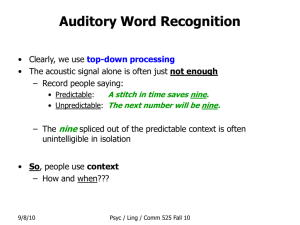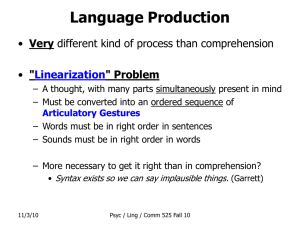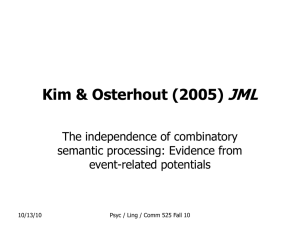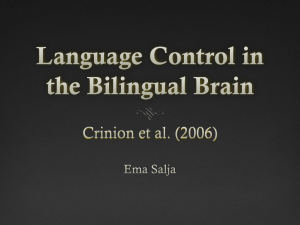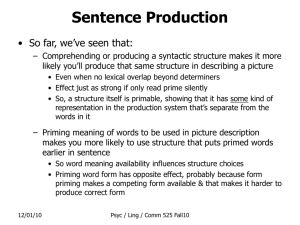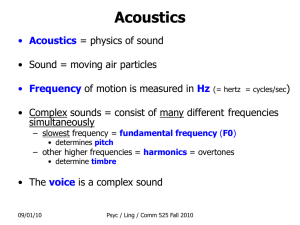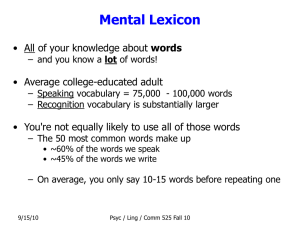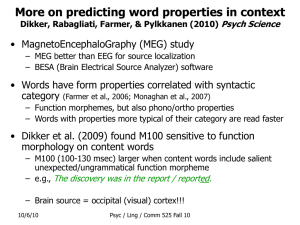Lexical Ambiguity Resolution Lecture
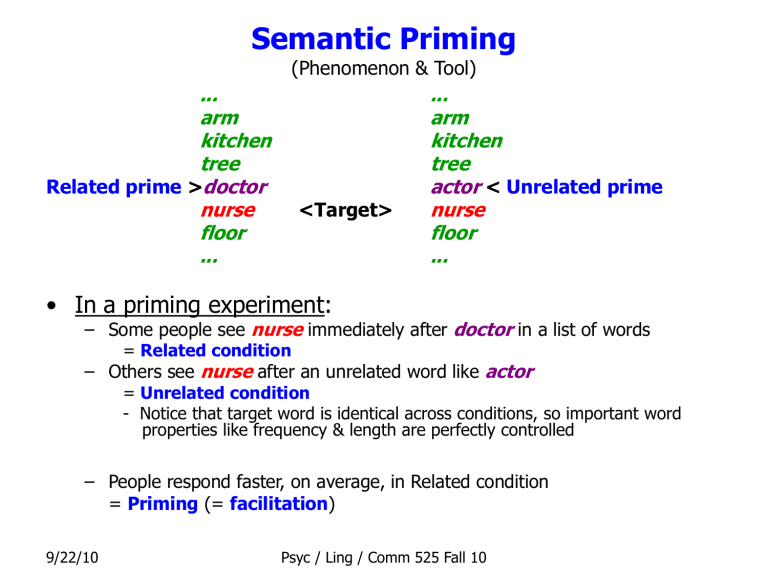
Semantic Priming
(Phenomenon & Tool)
...
arm kitchen tree
Related prime > doctor nurse floor
...
<Target>
...
arm kitchen tree actor < Unrelated prime nurse floor
...
• In a priming experiment:
– Some people see
= Related condition
– Others see nurse nurse immediately after doctor after an unrelated word like in a list of words actor
= Unrelated condition
- Notice that target word is identical across conditions, so important word properties like frequency & length are perfectly controlled
– People respond faster, on average, in Related condition
= Priming (= facilitation )
9/22/10 Psyc / Ling / Comm 525 Fall 10
Lexical Ambiguity Resolution
• Many words have multiple meanings
– plant , bank , bug , deck , ...
• Ambiguous words occur far more often than we realize
• We're so good at figuring out which meaning is intended that we rarely notice any ambiguity
– How do we do it?
– Do we retrieve multiple meanings as part of recognizing the word, & then pick the right meaning for the context?
• Multiple Access (= Modular)
• Or does context act to prevent us from ever even retrieving the irrelevant meaning?
• Selective Access (= Interactive)
9/22/10 Psyc / Ling / Comm 525 Fall 10
Semantic Priming with Ambiguous Words
...
arm window book bug spy car
...
Related
Targets
Ambiguous prime
...
arm window book bug ant car
...
...
arm window book bug sew car
...
Unrelated
Target
• In word lists, both related targets show facilitation
– Notice, in this design, it’s the prime that stays constant across conditions & the target that differs
• Have to work hard to control properties of target that affect RT
• What happens in sentences where it’s clear which meaning is intended?
9/22/10 Psyc / Ling / Comm 525 Fall 10
• Notice there’s a clever trick here
– Use a prime that has some kind of uncertainty about it
• Could be visually degraded
• Or lexically ambiguous
– Use targets related to different possible interpretations of prime
• If the response to a target is facilitated
• then the interpretation of the prime related to that target must have been “active”
– So, using response to target to figure out how prime processed
– Can vary time lag between prime & target to tap into prime processing at different points
= Stimulus Onset Asynchrony (SOA)
9/22/10 Psyc / Ling / Comm 525 Fall 10
Swinney (1979)
• Cross-modal priming study
• Primes = auditory sentence containing critical prime word
• Task = lexical decision on visual targets
• 4 kinds of auditory prime sentences:
The man was surprised when he found several ...
... insects
... bugs
... spiders, roaches, and other insects
... spiders, roaches, and other bugs in the corner of the room.
in the corner of the room.
in the corner of the room.
in the corner of the room.
^ ant (contextually approp) spy (contextually inapprop) sew (unrelated) sew aln (non-word) aln
9/22/10 Psyc / Ling / Comm 525 Fall 10
Swinney (1989)
Notice, very complex design !!!
• 2 (Context vs No Context)
• x 2 (Ambiguous vs Unambiguous Prime)
• x 2 (Prime-Target SOA)
• x 4 (Target Word Type)
= 32 conditions !
– 144 participants !
9/22/10 Psyc / Ling / Comm 525 Fall 10
Unambiguous Conditions
9/22/10 Psyc / Ling / Comm 525 Fall 10
9/22/10 Psyc / Ling / Comm 525 Fall 10
9/22/10 Psyc / Ling / Comm 525 Fall 10
• Swinney's study is important because:
– It shows how fast things change during comprehension
– It made sense of conflicting previous results
• whether you get evidence of interaction depends on when measure
– The multiple access results are so counterintuitive!
• More recent results have modified the conclusion:
– IF one meaning of an ambiguous word is much more common
• Swinney didn’t manipulate this property of ambiguous words
– AND context strongly supports the more common meaning
– THEN, only the contextually appropriate meaning seems to be activated
– So, when meaning frequency and context gang up, can get selective access (Duffy, Morris, & Rayner, 1988)
• Rather than priming for a related target, they measured reading times on ambiguous words and the words after them with an eyetracker
• Times were just as fast for ambiguous words as for unambiguous control words if there was plenty of context supporting the more frequent meaning of the ambiguous word
9/22/10 Psyc / Ling / Comm 525 Fall 10
9/22/10 Psyc / Ling / Comm 525 Fall 10
9/22/10 Psyc / Ling / Comm 525 Fall 10
9/22/10 Psyc / Ling / Comm 525 Fall 10
Van Petten & Kutas (1987)
9/22/10
Context always supported less frequent meaning
- So, should get priming for targets related to both meanings
Psyc / Ling / Comm 525 Fall 10
Naming Time Results
25
44
18
27
24
9
At 200 msec SOA, priming smaller but still reliable for contextually inappropriate target
At 700 msec SOA, reliable priming only for the contextually appropriate target
Replicates the pattern of results in Swinney’s study (statistically, at least)
Consistent with Duffy et al.’s frequency effects
9/22/10 Psyc / Ling / Comm 525 Fall 10
Taken as evidence of
“backward priming”
- ERPs can show this because continuous measure rather than tapping into just one point in time
ERP Results
For first 500 msec,
Inapprop patterns with Unrelated
Then, changes to become more like
Approp target
9/22/10 Psyc / Ling / Comm 525 Fall 10
Classic
N400 priming effect
Only
Approp target primed
Backward Priming
• Apparent multiple access at short SOA is artifactual
– A target word related to the contextually inappropriate meaning of an ambiguous prime word that is presented while the prime is still being processed causes retrieval of that inappropriate meaning
– Maybe that’s why multiple access only at short SOAs
• Rather than because context selects appropriate meaning quickly after multiple access
9/22/10 Psyc / Ling / Comm 525 Fall 10
Another Possibility
In many sentences, other words in context could prime the Appropriate target before the ambiguous prime word has any effect at all
- So early part of waveform could be due to priming from other words
- Then when the ambiguous word is processed sufficiently, it kicks in & primes both targets
9/22/10 Psyc / Ling / Comm 525 Fall 10
